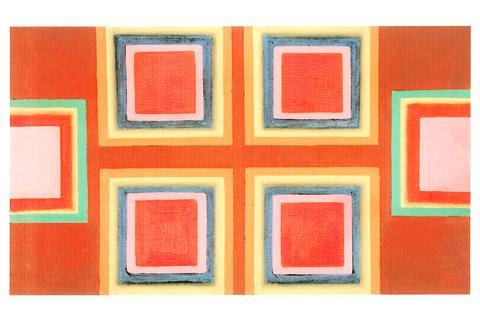Walking around the geometric abstraction exhibition at the Taipei Fine Arts Museum, one explores the varieties of Taiwanese abstract art, as well as examining the melding of Western concepts with Eastern philosophy that created a unique movement in Taiwan.
The Lyricism of Form: Geometric Abstraction highlights more than 50 pieces from 14 Taiwanese artists and spans the history of the movement in Taiwan from its onset in the 1960s to the present day.

Near the entrance of the exhibition is Chen Shiu-ming's (
Hu Kun-jung's (
Artists such as Richard Lin (
Images of folk art are also rich in Shiy De Jinn's (
From a postmodern perspective, Chang Cheng-jen (
When viewed as a whole, there doesn't seem to be a common thread underlining the exhibit, nor is it arranged in any particular order, chronological or otherwise. It does, however, examine the numerous influences -- both Western and Chinese -- that lead to a variegated abstract movement in Taiwan. The exhibit also provides an impressive overview of the group of artists who constructed the movement.
Equally interesting is how these pieces, which were originally influenced by works from the late 19th century, have become commonplace, mass-produced interior designs in bars, clubs and local homeware stores around the globe.
Exhibition notes:
What: The Lyricism of Form: Geometric Abstraction
Where: Taipei Fine Arts Museum (台北市立美術館) 181 Zhongshan N Rd, Sec 3, Taipei (臺北市中山北路3段181號).
Telephone: (02) 2595 7656
When: Until Oct. 10, Tuesday to Sunday from 9:30am to 5:30pm. Closed on Mondays

In the March 9 edition of the Taipei Times a piece by Ninon Godefroy ran with the headine “The quiet, gentle rhythm of Taiwan.” It started with the line “Taiwan is a small, humble place. There is no Eiffel Tower, no pyramids — no singular attraction that draws the world’s attention.” I laughed out loud at that. This was out of no disrespect for the author or the piece, which made some interesting analogies and good points about how both Din Tai Fung’s and Taiwan Semiconductor Manufacturing Co’s (TSMC, 台積電) meticulous attention to detail and quality are not quite up to

It is one of the more remarkable facts of Taiwan history that it was never occupied or claimed by any of the numerous kingdoms of southern China — Han or otherwise — that lay just across the water from it. None of their brilliant ministers ever discovered that Taiwan was a “core interest” of the state whose annexation was “inevitable.” As Paul Kua notes in an excellent monograph laying out how the Portuguese gave Taiwan the name “Formosa,” the first Europeans to express an interest in occupying Taiwan were the Spanish. Tonio Andrade in his seminal work, How Taiwan Became Chinese,

Mongolian influencer Anudari Daarya looks effortlessly glamorous and carefree in her social media posts — but the classically trained pianist’s road to acceptance as a transgender artist has been anything but easy. She is one of a growing number of Mongolian LGBTQ youth challenging stereotypes and fighting for acceptance through media representation in the socially conservative country. LGBTQ Mongolians often hide their identities from their employers and colleagues for fear of discrimination, with a survey by the non-profit LGBT Centre Mongolia showing that only 20 percent of people felt comfortable coming out at work. Daarya, 25, said she has faced discrimination since she

April 21 to April 27 Hsieh Er’s (謝娥) political fortunes were rising fast after she got out of jail and joined the Chinese Nationalist Party (KMT) in December 1945. Not only did she hold key positions in various committees, she was elected the only woman on the Taipei City Council and headed to Nanjing in 1946 as the sole Taiwanese female representative to the National Constituent Assembly. With the support of first lady Soong May-ling (宋美齡), she started the Taipei Women’s Association and Taiwan Provincial Women’s Association, where she